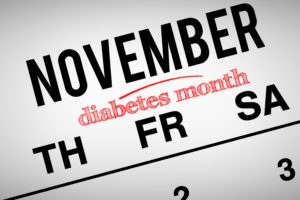November is National Pet Diabetes Awareness Month, so we thought we’d take some time to highlight the disease and review the symptoms of diabetes in dogs and cats.
Diabetes is an endocrine disorder that affects the way the body produces or processes the hormone insulin, which helps the body turn glucose (sugar) from food into energy. Here is a simplified version of what happens:
When food is digested, it is broken down into many smaller components to be used by the body as fuel. Carbohydrates are broken down into many components, including a simple sugar called glucose, which provides energy to fuel the body. The hormone insulin moves through the bloodstream, entering cells to help convert glucose into fuel. If the pancreas makes too little insulin or the body can’t process it properly, glucose can’t get into the cells. Glucose (sugar) begins to build up in the bloodstream, triggering the pancreas to release more insulin to balance blood sugar levels. The resulting blood sugar drop triggers hunger, and the cycle of highs and lows begins all over again. As a result, a diabetic animal may want to eat constantly, but because its cells can’t absorb and convert glucose into energy, the animal will be malnourished and lethargic.
 According to the American Veterinary Medical Association:
According to the American Veterinary Medical Association:
“Obesity is a significant risk factor for development of diabetes. As dogs and cats age, they may also develop other diseases that can result in diabetes or could significantly affect their response to treatment for diabetes, including overactivity of the adrenal gland in dogs (hyperadrenocorticsm) or overactivity of the thyroid gland in cats (hyperthyroidism), pancreatitis, heart disease, kidney disease, urinary tract infections and skin infections.The long-term use of medications containing corticosteroids is also a risk factor for diabetes.”
If your dog is experiencing the following symptoms, make a veterinary appointment as they could be indicators that your dog has diabetes. Please note that these symptoms overlap with many other health conditions, so blood work is required to make a proper diagnosis.
- Change in appetite
- Excessive thirst/increase in water consumption
- Weight loss
- Increased urination
- Unusually sweet-smelling or fruity breath
- Lethargy
- Dehydration
- Urinary tract infections
- Vomiting
- Cataract formation, blindness
- Chronic skin infections
Diabetes is the second most common endocrine disease in cats. If your cat is experiencing the following symptoms, make a veterinary appointment as they could be indicators that your cat has diabetes. Please note that these symptoms overlap with many other health conditions, so blood work is required to make a proper diagnosis.
- Increased thirst (polydipsia) and urination (polyuria)
- Inappropriate elimination (cats also experience increased urinary tract infections)
- Change in appetite (increased or decreased appetite is an indicator of a problem)
- Weight loss
- Change in gait (walking)
- Decreased activity, weakness, depression
- Vomiting
Diabetes can be managed, so if your pet has symptoms, do not delay. Make an appointment with your veterinarian to make sure your pet can live a longer, healthier life.


